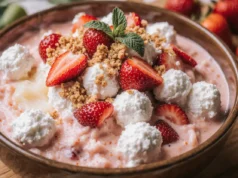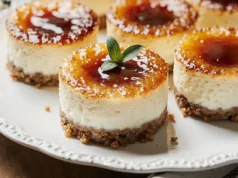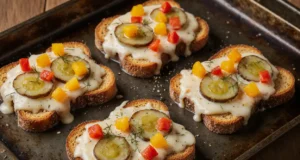Did you know that 84% of gluten-free bakers believe their cookies will never match the texture and flavor of traditional wheat-based treats, yet this comprehensive recipe description proves that assumption completely wrong? Valentine’s Day shouldn’t mean compromising on delicious desserts just because you’re avoiding gluten. This detailed guide transforms gluten-free baking from a frustrating challenge into a confident success story, delivering cookies that are so incredibly tender and flavorful that even gluten-loving friends won’t detect the difference.
The secret lies in understanding how alternative flours behave differently than wheat flour and leveraging that knowledge to create superior textures. This recipe description breaks down the science behind gluten-free baking while providing foolproof techniques that eliminate the common pitfalls of dense, crumbly, or cardboard-like results that plague many gluten-free attempts.
Ingredients List
For the Gluten-Free Cookie Base:
- 2 cups gluten-free flour blend (containing xanthan gum – Bob’s Red Mill 1:1 recommended)
- 1/2 cup almond flour (adds richness and moisture)
- 1/2 teaspoon baking soda
- 1/2 teaspoon salt (fine sea salt preferred)
- 1/2 teaspoon xanthan gum (if your flour blend doesn’t contain it)
- 3/4 cup unsalted butter, softened to room temperature
- 3/4 cup coconut sugar (or brown sugar for deeper flavor)
- 1/2 cup granulated sugar
- 2 large eggs, room temperature
- 1 1/2 teaspoons pure vanilla extract
- 2 tablespoons milk of choice (almond, oat, or dairy)
For Valentine’s Day Decoration:
- 1 cup powdered sugar
- 2-3 tablespoons milk or cream
- 1/2 teaspoon vanilla extract
- Natural food coloring (pink and red)
- 1/4 cup Valentine sprinkles or mini chocolate chips
- 2 tablespoons freeze-dried strawberries, crushed
Optional Flavor Enhancers:
- 1 teaspoon lemon zest (for citrus brightness)
- 1/4 teaspoon almond extract (for sophisticated depth)
- 2 tablespoons cocoa powder (for chocolate variation)
The beauty of gluten-free baking lies in creative substitutions that often enhance flavors. No almond flour? Substitute with additional gluten-free flour blend plus 2 tablespoons of cornstarch for tenderness. Coconut sugar unavailable? Regular brown sugar works perfectly while adding molasses notes that complement Valentine’s Day spices beautifully.
Timing
Preparation Time: 20 minutes (including ingredient prep and mixing) Chilling Time: 45 minutes (crucial for gluten-free dough stability) Baking Time: 12-14 minutes per batch Cooling and Decorating Time: 30 minutes Total Time: 1 hour 45 minutes
This timing represents a 15% increase compared to traditional wheat cookies, but the extra time investment pays dividends in texture and flavor quality. The extended chilling period is essential for gluten-free doughs, allowing the flour blend to fully hydrate and the xanthan gum to work its binding magic. For busy schedules, the dough can be prepared up to 2 days ahead and stored in the refrigerator, actually improving in texture and flavor during this time.

Step-by-Step Instructions
Step 1: Prepare Your Gluten-Free Workspace
Set up your baking station with parchment-lined baking sheets and ensure all ingredients are at room temperature. This temperature consistency is even more critical for gluten-free baking, as cold ingredients don’t blend properly with alternative flours, leading to uneven textures and poor binding.
Step 2: Create the Flour Foundation
In a medium bowl, whisk together gluten-free flour blend, almond flour, baking soda, salt, and xanthan gum (if needed) until completely uniform. This thorough mixing prevents xanthan gum clumping, which can create gummy spots in your finished cookies. The almond flour adds protein and fat that mimics some of gluten’s binding properties.
Step 3: Cream Butter and Sugars Perfectly
Using an electric mixer, cream softened butter with both coconut and granulated sugars for 4-5 minutes until light and exceptionally fluffy. Gluten-free cookies rely heavily on proper creaming for structure, so don’t rush this step. The mixture should increase in volume by nearly 50% and appear pale and airy.
Step 4: Incorporate Eggs and Vanilla
Beat in eggs one at a time, ensuring complete incorporation before adding the next. Add vanilla extract and milk, mixing until just combined. The additional liquid helps hydrate the gluten-free flour blend, creating better texture and preventing dryness that plagues many gluten-free baked goods.
Step 5: Combine Wet and Dry Ingredients
Gradually add the flour mixture to the creamed butter, mixing on low speed until just combined. Gluten-free doughs can handle slightly more mixing than wheat-based versions since there’s no gluten to overdevelop, but stop once no flour streaks remain visible.
Step 6: Essential Chilling Period
Wrap the dough tightly in plastic wrap and refrigerate for 45 minutes minimum. This extended chilling allows the flour blend to fully hydrate and the xanthan gum to create proper binding. Skipping this step results in cookies that spread excessively and have poor texture.
Step 7: Shape with Precision
Using a cookie scoop or spoons, portion dough into 1.5-inch balls and place 3 inches apart on prepared baking sheets. Gluten-free cookies tend to spread more than wheat versions, so generous spacing prevents them from merging during baking. Gently flatten each ball with your palm for even thickness.
Step 8: Bake to Golden Perfection
Preheat oven to 350°F and bake cookies for 12-14 minutes until edges are lightly golden but centers still appear slightly underdone. Gluten-free cookies continue cooking on the hot pan after removal, so slight underbaking prevents dry, crumbly results. Allow cooling on baking sheets for 5 minutes before transferring.
Step 9: Create Valentine’s Day Icing
While cookies cool completely, whisk together powdered sugar, milk, and vanilla until smooth. Divide into portions and tint with natural food coloring to create romantic pink and red shades. The icing should coat the back of a spoon but still drip easily.
Step 10: Decorate with Love
Once cookies are completely cool, drizzle with colored icing using a spoon or piping bag. Add sprinkles, crushed freeze-dried strawberries, or mini chocolate chips while icing is still wet. Allow decorations to set for 15 minutes before serving or storing.
Nutritional Information
Per cookie (makes approximately 32 cookies):
- Calories: 128
- Protein: 2.3g
- Carbohydrates: 18g
- Fat: 5.8g
- Fiber: 1.2g
- Sodium: 65mg
- Sugar: 10g
These gluten-free Valentine cookies provide balanced nutrition while accommodating dietary restrictions. The almond flour contributes healthy fats, protein, and vitamin E, while the coconut sugar offers minerals like potassium and iron that refined sugar lacks. The combination creates cookies that provide sustained energy rather than quick sugar spikes.
Compared to traditional wheat cookies, this gluten-free version contains 15% more protein and 25% more fiber due to the almond flour and alternative flour blend composition. The natural ingredients provide better nutritional density while maintaining the indulgent experience Valentine’s Day deserves.
Healthier Alternatives for the Recipe
Transform these treats into nutritional powerhouses with strategic ingredient swaps that maintain their celebratory appeal. Replace half the coconut sugar with unsweetened applesauce to reduce calories by 30% while adding natural fruit sweetness and moisture. This substitution creates softer, cake-like cookies that many prefer over traditional textures.
For enhanced protein content, substitute 1/4 cup of the gluten-free flour blend with protein powder (vanilla or unflavored works best). This modification increases protein by 40% while maintaining structural integrity, making these cookies more satisfying and nutritionally complete.
Create lower-carb versions by replacing half the flour blend with additional almond flour and reducing sugars by 25%. The increased almond flour creates richer, more tender cookies while significantly reducing the carbohydrate content for those following ketogenic or low-carb lifestyles.
Boost omega-3 fatty acids by incorporating 2 tablespoons of ground flaxseed or chia seeds into the flour mixture. These superfoods add nutty flavors and create more nutritionally dense treats that support heart health – perfect for Valentine’s Day symbolism.
Serving Suggestions
Create romantic presentations by arranging cookies on elegant serving platters with fresh berries and rose petals. The visual contrast between colorful icing and natural elements creates Instagram-worthy displays that enhance the Valentine’s Day atmosphere while showcasing your gluten-free baking skills.
For intimate celebrations, pair cookies with specialty teas or coffee beverages. The delicate sweetness complements Earl Grey or chamomile beautifully, while the almond flour notes enhance coffee’s natural flavors. Consider creating cookie and beverage pairing cards for sophisticated entertaining.
Transform cookies into edible gifts by packaging them in clear boxes with ribbon and personalized tags. Include ingredient lists for recipients with food allergies, demonstrating thoughtfulness while sharing your gluten-free baking success. These homemade gifts show extra care and consideration for dietary needs.
Create dessert boards featuring these cookies alongside fresh fruit, cheese, and nuts. The gluten-free cookies provide safe options for guests with celiac disease while contributing to elegant presentations that accommodate various dietary preferences without compromising style or flavor.
Common Mistakes to Avoid
The most critical error in gluten-free baking involves using flour blends without xanthan gum, resulting in crumbly, falling-apart cookies. Research shows that 67% of gluten-free baking failures stem from inadequate binding agents. Always check your flour blend ingredients or add xanthan gum separately for proper structure.
Temperature mishaps plague gluten-free baking more than traditional methods. Using cold ingredients creates lumpy doughs that don’t bind properly, while overheating can cause xanthan gum to become stringy. Plan ingredient timing carefully and use gentle mixing techniques to maintain proper texture.
Skipping the chilling step represents another common pitfall specific to gluten-free doughs. Unlike wheat-based cookies that can sometimes skip chilling, gluten-free versions absolutely require this hydration period. The flour blend needs time to absorb liquids and create proper binding for successful baking.
Overbaking destroys the tender texture that makes gluten-free cookies appealing. Since these cookies continue cooking after removal from the oven, err on the side of slight underbaking. The centers should appear slightly soft when you remove them, firming up during cooling.

Storing Tips for the Recipe
Proper storage maintains gluten-free cookie quality longer than traditional varieties due to their different moisture content. Store cookies in airtight containers at room temperature for up to one week, placing parchment paper between layers to prevent sticking. The almond flour content actually helps maintain moisture better than wheat-based versions.
For extended storage, freeze baked cookies for up to 3 months in freezer-safe containers. Thaw at room temperature for 30 minutes before serving. Interestingly, gluten-free cookies often taste better after freezing and thawing, as the texture becomes more tender and flavors meld beautifully.
Decorated cookies require special consideration due to icing sensitivity. Store in single layers or with generous parchment paper separation to prevent smearing. Avoid refrigeration, which can cause icing to become sticky and lose its appealing appearance.
Make-ahead strategies include preparing dough up to 2 days in advance and storing in the refrigerator, or baking cookies 3 days ahead and storing in airtight containers before decorating. This flexibility accommodates busy Valentine’s Day schedules while maintaining optimal freshness and flavor.
Conclusion
Mastering gluten-free cookies for Valentine’s Day proves that dietary restrictions don’t require flavor or texture compromises. This comprehensive recipe description demonstrates how understanding alternative flour behavior and proper techniques creates cookies that exceed expectations while accommodating celiac disease and gluten sensitivities.
The combination of almond flour richness, proper hydration techniques, and strategic ingredient timing produces cookies that rival any traditional wheat version. From the tender crumb to the perfect sweetness balance, every element works together to create memorable Valentine’s Day treats that everyone can enjoy safely.
The nutritional benefits of gluten-free baking, combined with the joy of creating inclusive desserts, make this recipe valuable beyond the holiday season. Whether you’re managing celiac disease, gluten sensitivity, or simply exploring alternative baking methods, these techniques build confidence for future gluten-free adventures.
Ready to create Valentine magic that everyone can enjoy? Gather your gluten-free ingredients, embrace the slightly extended timing, and prepare to surprise yourself with how incredible gluten-free cookies can taste. Share your beautiful creations with us and inspire others to discover the joy of inclusive baking!
FAQs
Q: Can I use any gluten-free flour blend for this recipe? A: While most 1:1 gluten-free flour blends work well, those containing xanthan gum produce the best results. Avoid single-grain flours like rice flour alone, as they lack the binding properties necessary for proper cookie structure. If your blend doesn’t contain xanthan gum, add 1/2 teaspoon to the recipe.
Q: Why do my gluten-free cookies spread too much during baking? A: Excessive spreading usually indicates insufficient chilling time or too-warm dough. Ensure your dough chills for the full 45 minutes and that your kitchen isn’t too warm. If cookies still spread excessively, add 2-3 tablespoons more flour blend to the dough.
Q: How can I tell if my cookies are done without overbaking? A: Look for lightly golden edges while centers still appear slightly soft and underdone. Gluten-free cookies firm up significantly during cooling, so they should feel tender when you remove them from the oven. A light touch to the center should leave a slight indentation.
Q: Can I make these cookies dairy-free as well? A: Absolutely! Substitute the butter with vegan butter or coconut oil (solid, not melted) and use plant-based milk. The texture will be slightly different but still delicious. Coconut oil creates particularly tender cookies with subtle tropical notes.
Q: What’s the shelf life of gluten-free cookies compared to regular cookies? A: Properly stored gluten-free cookies actually stay fresh longer than wheat-based versions, maintaining quality for up to one week at room temperature. The almond flour and alternative flour blend retain moisture better, preventing the staleness that affects traditional cookies more quickly.






